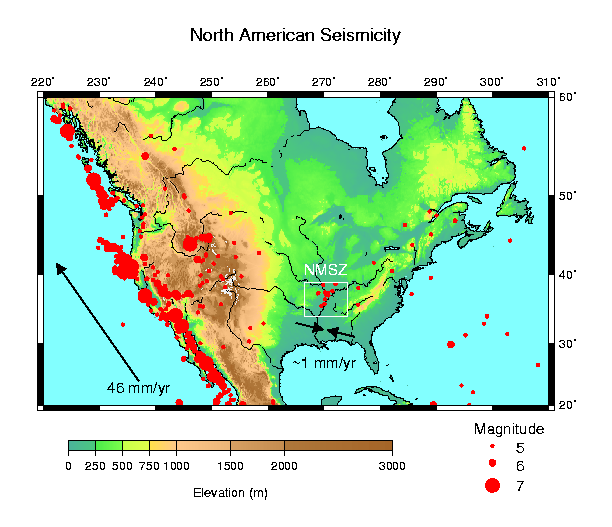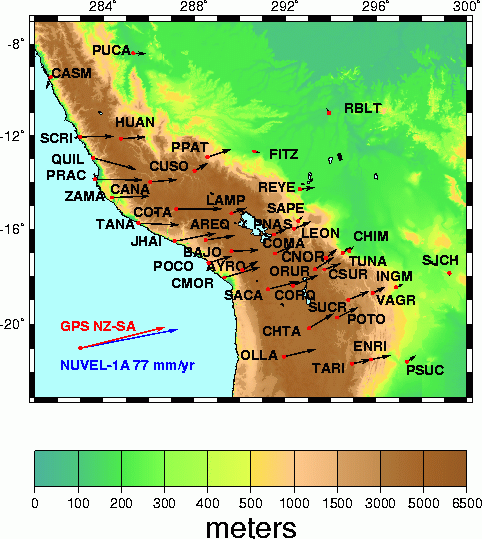Seth Stein, students, and coworkers have studied how global plate motions over geologic time (millions of years) compare with those over a few years measured from space geodesy, and explored these data’s implications for the evolution of the continents. This was addressed by programs using the Global Positioning System (GPS) satellites to study the New Madrid seismic zone and Andes. These studies are among the many that use the Global Positioning System satellites and other space-based techniques to measure positions on the Earth far more precisely than would have been dreamed possible not long ago. Before this, geologists could only study the motion of the great plates of Earth’s lithosphere (which move at speeds of a few inches per year, about the speed fingernails grow) over periods of millions of years, long enough for large motions to accumulate. Now, however, very precise positioning makes it possible to study plate motions over a period of years.
Working with former students A. Newman (now at Georgia Tech), J. Weber (now at Grand Valley State University), J. Engeln (now Assistant Director of the Missouri Department of Natural Resources), and T. Dixon from the University of Miami Geodesy Lab, we conducted a multi-institutional GPS program to quantify the rate and distribution of strain accumulation in the New Madrid, Missouri, seismic zone (NMSZ), where great earthquakes occurred in 1811-1812. This area provides a type example of large earthquakes within a relatively stable continental interior. Assessing the scale and causes of deformation in such regions, as well as estimation of the recurrence interval for the large earthquakes within them, has long been recognized as an important but challenging issue, for which the advent of space-based geodesy provided an important new tool.
 Using GPS, the positions of a network of geodetic markers in Missouri, Tennessee, Illinois, Arkansas, and Kentucky have been measured to accuracies of better than an inch since 1991. Data were collected with the help of many NU, Missouri, and GVSU students, and technical support by UNAVCO, a national consortium of universities using the Global Positioning System for geological research. The GPS results show little or no motion across the seismic zone, implying that the seismic hazard of a great New Madrid earthquake may have been greatly overestimated.
Using GPS, the positions of a network of geodetic markers in Missouri, Tennessee, Illinois, Arkansas, and Kentucky have been measured to accuracies of better than an inch since 1991. Data were collected with the help of many NU, Missouri, and GVSU students, and technical support by UNAVCO, a national consortium of universities using the Global Positioning System for geological research. The GPS results show little or no motion across the seismic zone, implying that the seismic hazard of a great New Madrid earthquake may have been greatly overestimated.
This result is consistant with an analysis of GPS platewide data, conducted with postdoc G. Sella, and T. Dixon and A. Mao (University of Miami Geodesy Lab). GPS site motions (arrows in the figure) show beautifully the difference between the North American plate and the Pacific-North America plate boundary zone. Within the plate, sites move in small circles about the plate rotation pole (star) at a rate increasing with distance, whereas motions in the boundary zone differ noticeably. These data show that the plate is stable to better than 2 mm/yr, in that it can be described by a single Euler vector, and find insignificant motion across the NMSZ.
Data from the Andes program termed SNAPP (South America – Nazca Plate motion Project), a joint project with graduate student L. Lefffler, and E. Norabuena and T. Dixon (University of Miami Geodesy Lab), provided a profile of relative plate motion across the Nazca-South America plate boundary zone through the Central Andes derived by a combination of space geodetic techniques. The profile extends from the stable interior of the oceanic Nazca plate, across the Peru-Chile trench to the coastal forearc, across the high Altiplano and foreland thrust belt, and into the stable interior of the South American continent. Space geodetic data directly measure rates and directions of motion in different portions of the plate boundary zone, which could previously only be estimated indirectly. The data indicate that about 30-40 mm/yr of slip, roughly half of the overall convergence rate, is accumulating on the locked plate boundary thrust fault and should be released in future great earthquakes. This estimate avoids some of the difficulties inherent in previous seismic slip estimates based on the earthquake history. We also estimated that about 10-15 mm/yr of crustal shortening occurs inland at the sub-Andean foreland fold and thrust belt, indicating that the Andes are continuing to build. We observed little (5-10 mm/yr) along-trench motion of coastal forearc slivers, despite the oblique convergence geometry. The results illustrate the value of space geodesy for investigating ocean-continent convergence and continental mountain building. They are shown on the figure below, with topography of the central Andes (mountains shown in brown) and nearby regions, GPS site (triangles), and their velocities relative to stable South America. Arrows show the direction the site moves, and the ellipses show the uncertainty associated with each measurement. The motion of the sites toward the stable interior of the South American continent demonstrate the accumulation of strain that will be released in large earthquakes and the permanent deformation that builds the Andes.
Another project used GPS to look at present motions associated with the response of the Earth to the great mile-thick ice sheets that covered the area 18,000 years ago. Long after the glaciers melted, we used the Global Positioning System (GPS) satellites to “see” the land moving — up to half an inch per year in some places — as the earth rebounds in response to the ice that once pushed the land down. Looking at data from more than 200 sites across the continent shows a spectacular pattern. While sites in Canada are rising, with those near Hudson Bay — which is where the ice load was heaviest — rising the fastest, U.S. sites south of the Great Lakes are sinking instead of rebounding. These small motions resulting from post-glacial rebound” stem from the fact that the mantle below the earth’s crust flows like a super-viscous fluid — much, much stickier than road tar or maple syrup. The mantle is still flowing to fill areas underneath the places where the heavy ice sheets pushed out the mantle 18,000 years ago. Post-glacial rebound also affects the water levels of the Great Lakes. As the northern shores rise, water levels are steadily decreasing. Conversely, as the southern shores sink, water levels are rising. This impacts not only industries and homeowners along the shores of the Great Lakes but also the international management of water levels, dams, and shipping. These small motions may also be one of the causes of the mysterious earthquakes that occur in the center of the North American continent, including the St. Lawrence Valley, northern New England, and perhaps even the New Madrid earthquake zone in the central U.S., and along the Atlantic coast including Newfoundland. Project participants are former postdoc Giovanni Sella (now with the National Geodetic Survey) and Stein; Timothy Dixon and Shimon Wdowinski from University of Miami; Michael Craymer from the Geodetic Survey Division of Natural Resources Canada; Thomas James and Stephane Mazzotti from the Geological Survey of Canada of Natural Resources Canada; and Roy Dokka from Louisiana State University. The figure below is from Sella et al (2006).
For the paper describing the GPS observations of post-glacial adjustment click here.
For the data in the figure click here.
For a Powerpoint presentation from the press conference about using GPS to look at post-glacial rebound click here.
For a press release (pdf) about using GPS to look at post-glacial rebound click here.
For the Chicago Tribune story about this project click here.

